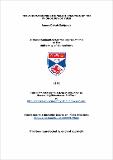Files in this item
An axiomatic functionalist analysis of the phonology of Yulu
Item metadata
| dc.contributor.advisor | Mulder, J. W. F. | |
| dc.contributor.author | Gabjanda, James Dahab | |
| dc.coverage.spatial | 230 | en_US |
| dc.date.accessioned | 2012-06-05T11:07:42Z | |
| dc.date.available | 2012-06-05T11:07:42Z | |
| dc.date.issued | 1976 | |
| dc.identifier.uri | https://hdl.handle.net/10023/2642 | |
| dc.description.abstract | This thesis is concerned with the description of Yulu, a language which has not previously been subjected to modern linguistic analysis. Thus this thesis has two important aspects. Firstly, however remote a Language, its description adds a valuable contribution to linguistic knowledge. Secondly, its description tests the validity of linguistic theories in general and the theory used in this work in particular; as a linguist should not only be able to describe one universal but any number of parallel universes of speech-phenomena, namely different languages or dialects or even idiolects. Since the theory has been instrumental in describing the phonological system of Yulu in a consistent and adequate manner, it has once again proved its usefulness as a 'general' linguistic theory. The theory applied is that of Professor J. W. F. Mulder and is a sub-component of his 'Axiomatic Functionalist Linguistics'. This thesis is divided into three parts. Part I, dealing with the theoretical background, comprises twelve chapters, of which the first four provide an introduction to the basic principles of axiomatic functionalism. The remaining eight chapters introduce the theoretical notions of phonological theory and analysis as practised by axiomatic functionalists. Chapter I deals with the axiomatic functionalist principle of maintaining a strict distinction between the linguistic theory, linguistic descriptions, and the speech-phenomena and also with the basic criteria for evaluating both the linguistic theory and linguistic descriptions. Chapter II, dealing with the 'hypothetico-deductive Method', explains the philosophical principles underlying the axiomatic functionalist approach, Chapter III deals with 'The origin and scope of the theory'. Chapter IV explains the definition of 'language' as "a semiotic system with a 'double articulation'" (Mulder 1968). Chapter V covers 'The domain of phonology'; Chapter VI 'The notion "phoneme" as defined in axiomatic functionalism'; Chapter VIII 'The "abstract" approach to phonology'; Chapter VIII is concerned with 'Identity and distinctive function of a phoneme'; Chapter IX with 'Phonematics'; Chapter X with 'Neutralization' and 'archiphoneme'; Chapter XI with 'phonemes and their realizations (allophony)'; and Chapter XII with 'Phonotactics’. Part II, consists of one basic chapter, and is intended to give general background information about Yulu - the language whose phonological analysis we are concerned with in this thesis. Part III, dealing with the actual phonological analysis consists of five chapters. Chapter I deals with 'The phonemes of Yulu and their realizations'; Chapter II 'Neutralization' and 'Concord'; Chapter III 'Classificatory calculus in Yulu'; Chapter IV 'Phonotactic distribution in Yulu'; and Chapter V 'The tones of Yulu'. | en_US |
| dc.language.iso | en | en_US |
| dc.subject.lcc | PL8825.G2 | |
| dc.subject.lcsh | Yulu language--Phonology | en_US |
| dc.subject.lcsh | Functionalism (Linguistics) | en_US |
| dc.title | An axiomatic functionalist analysis of the phonology of Yulu | en_US |
| dc.type | Thesis | en_US |
| dc.type.qualificationlevel | Doctoral | en_US |
| dc.type.qualificationname | PhD Doctor of Philosophy | en_US |
| dc.publisher.institution | The University of St Andrews | en_US |
This item appears in the following Collection(s)
Items in the St Andrews Research Repository are protected by copyright, with all rights reserved, unless otherwise indicated.

